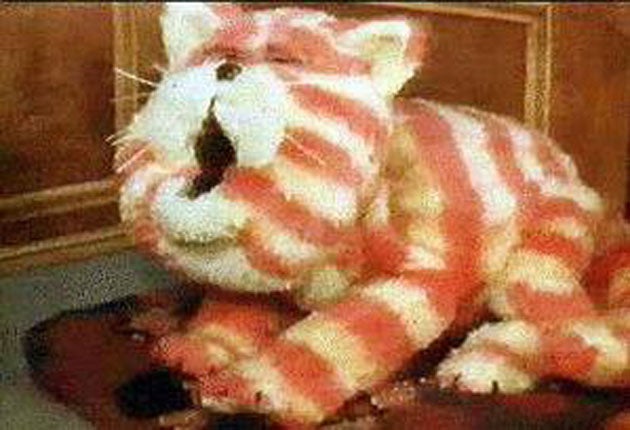Voice of Bagpuss goes to sleep
Generations of British children grew up in thrall to Oliver Postgate's animated creations. Lifelong fan John Walsh pays tribute to the man who gave us Noggin, the Clangers and Ivor the Engine

Oliver Postgate's voice was his most effective asset. The materials he used in his films for children were often rubbish - cast-off bits of grey felt or pink wool from a workbox, rudimentary pencil drawings on bits of card – and the animation was often feeble, but his voice carried you deep into the story. It was a voice of the utmost British authority, a low, house-masterly tone that throbbed with underlying melancholy. Where did it come from? Listen to the voiceover at the start of The Clangers (1969,) announcing, "This is our world..." and you realise it's pinched from the introduction ("This is the universe – big, isn't it?") to A Matter of Life and Death, made 23 years earlier by Powell and Pressburger – the epitome of English film-making in 1946. Postgate borrowed the distinctive timbre of wartime trustworthiness to communicate with children.
I first heard him at six when, on a titchy, 12in, black-and-white television screen, a wobbling title-board appeared, bearing the legend: Noggin the Nog. "Listen to me and I will tell you the story of Noggin the Nog, as it was told in days of old" confirmed a voice, in the dry, schoolroom style of WH Auden reciting The Seafarer: "In the lands of the north, where the black rocks stand guard against the cold sea, in the dark night that is very long, the men of the north sit by the great log fires and they tell a tale. Of how a prince built a long boat and..."
I was gripped. This was a real story, about adventure and death, a million miles from the six-year-old's comfort zone of woodland creatures and Noddy and Big Ears. It was close to Hans Andersen's creepy folk tales (which scared me stiff,) but was irresistible all the same.
Perhaps it helped that Noggin, the intrepid hero, had a face of saucer-eyed innocence to match his silly name, and you hoped the saga would turn out to be comical rather than frightening. It left me with a lifelong wariness of Norse sagas, and a love for elemental imagery – of sea, rocks, storm, night, fire, water, home – whether in the work of Ted Hughes, Seamus Heaney or children's authors such as Geraldine McCaughrean.
Postgate was an inspired minimalist who claimed that his surreal creativity was simply due to the big kid inside him. He was, in this respect, the spiritual father of Nick Park, creator of Wallace and Gromit, who never shakes off the air of a boy who wishes the grown-ups would leave him to play with his toys. Postgate dealt, like Park, with stop-animation, and was a brilliant innovator: Working with the artist Peter Firmin in a reconstituted cowshed in Blean, near Canterbury, he could churn out two minutes of usable stop-animation footage per day, at a time when animation studios could manage only two seconds a day. He invented a rudimentary click-switch for advancing the 16mm film camera frame by frame, while moving his characters minutely this way and that.
Creating something fine out of unpromising stuff was his forte, as it was for the team around Bagpuss, his masterpiece. There were only 13 episodes, but they've been repeated more often that Fawlty Towers. Each episode following a similar trajectory. A little girl called Emily owned a shop where she brought lost items home to be mended. A German-accented, pince-nez-wearing wooden woodpecker called Professor Yaffle inspected the object and sagely announced its function. The shop mice squeaked in alarm or delight until organised by Madeleine, the motherly rag doll, whereupon they'd start up their Mechanical Mouse Organ, accompanied by a banjo-strumming toad called Gabriel. When they'd put the thing back together, it went in the shop window, in the hope that its owner would find it one day while walking by. Was there ever, except in the pages of Dickens, such a combination of optimism, collective industry, kindness, and pathos? It is coincidence that Bagpuss started life in 1974, around the time of nationwide social unrest and the three-day week?
All his life, Postgate was politically outspoken (a conscientious objector in the war, a CND supporter, a New Statesman blogger,) and in his latter days he reserved a quantity of bile for modern children's TV producers. They were obliged, he said in 2003, to "hurtle from country to country, seeking subscriptions from the TV stations to fund the enormous cost of the films," and having, in so doing, to appeal to the widest (and dumbest) audience. He looked back nostalgically to a time when, having no budget to speak of, "we had to rely on the basic hand-writing of animation, laboriously pushing along cardboard characters with a pin. Thus we were thrown back on the real staple of television: telling and showing a good story..."
It's an old man's cantankerous reflection on how More has meant Worse, and money has made an expensive mess of a simple but effective formula. But it's hard to dispute his general conclusion about "the real staple of television". All one need do now is work out how Postgate somehow knew that children would respond with delight to a programme series about a group of whistling mice who live inside a blue planet, or that a drama concerning "an old saggy cloth cat, baggy and a bit loose at the seams" might become the best-loved UK children's show of all time.
Subscribe to Independent Premium to bookmark this article
Want to bookmark your favourite articles and stories to read or reference later? Start your Independent Premium subscription today.

Join our commenting forum
Join thought-provoking conversations, follow other Independent readers and see their replies